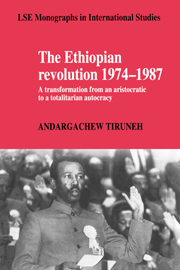 The Ethiopian Revolution 1974–1987
The Ethiopian Revolution 1974–1987 Published online by Cambridge University Press: 18 December 2009
‘REVOLUTIONARY ETHIOPIA OR DEATH’
Like most dictators, Mengistu was not only head of the government but also head of state and as such personified the state. As of 1977, therefore, it became increasingly difficult to distinguish between the threats directed against him and those directed against the state. By and large it can perhaps be stated that whereas the internal opposition was a threat against Mengistu's position as a leader, the external invasion can be taken as a threat both to him as a leader and to the state.
When Mengistu assumed absolutist powers in February 1977, the government was engulfed by internal and external threats with the result that Ethiopia looked as though it was on the point of dismemberment. In the urban centres, Mengistu's coalition was locked into an assassination and counter-assassination match with the EPRP. In the north-west, EDU had captured the border towns of Metema and Setit-Humera, and was poised to capture the provincial capital of Gondar. In the north, the Eritrean Liberation Front, the Eritrean People's Liberation Front, EDU and the Tigrai People's Liberation Front had brought chunks of the Eritrean and Tigrain countryside under their control and had besieged the major towns in those provinces. In the east, the Afar Liberation Front had been destroying military convoys and garrisons and periodically cutting the road leading to the only port of Assab which was still under government control.
To save this book to your Kindle, first ensure [email protected] is added to your Approved Personal Document E-mail List under your Personal Document Settings on the Manage Your Content and Devices page of your Amazon account. Then enter the ‘name’ part of your Kindle email address below. Find out more about saving to your Kindle.
Note you can select to save to either the @free.kindle.com or @kindle.com variations. ‘@free.kindle.com’ emails are free but can only be saved to your device when it is connected to wi-fi. ‘@kindle.com’ emails can be delivered even when you are not connected to wi-fi, but note that service fees apply.
Find out more about the Kindle Personal Document Service.
To save content items to your account, please confirm that you agree to abide by our usage policies. If this is the first time you use this feature, you will be asked to authorise Cambridge Core to connect with your account. Find out more about saving content to Dropbox.
To save content items to your account, please confirm that you agree to abide by our usage policies. If this is the first time you use this feature, you will be asked to authorise Cambridge Core to connect with your account. Find out more about saving content to Google Drive.